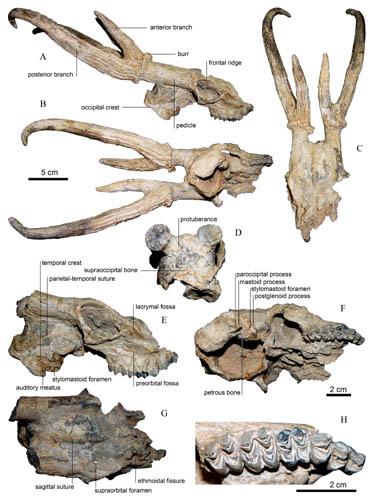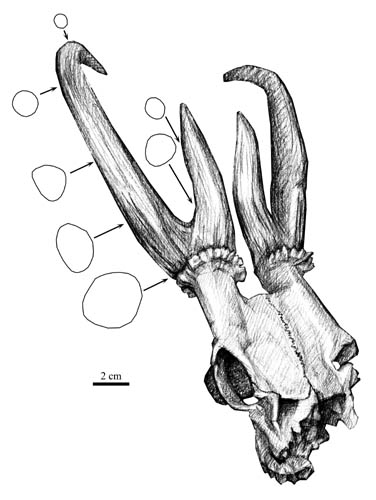| Location: Home > Research > Research Progress |
| First Known Skull of the Muntjak Eostyloceros Found in China |
|
Dr. DENG Tao from the Institute of Vertebrate Paleontology and Paleoanthropology, Chinese Academy of Sciences and his colleagues reported a new species of the muntjak Eostyloceros in the journal of Zootaxa 3893 (3) recently. The new species, Eostyloceros hezhengensis sp. nov., is established based on a skull with its cranial appendages collected from the Late Miocene Liushu Formation of the Linxia Basin in Gansu Province, northwestern China. It is a large-sized muntjak with a distinct longitudinal ridge along the lateral margin of the frontal bone that joins the antler pedicle. The pedicle is short, cylindrical, robust, and extends posteriorly from the rear of the orbit. The anterior and posterior branches arise from the burr and diverge at an angle of 30°. The posterior branch is relatively long, and its tip is strongly curved posteriorly. The anterior branch is straight and situated anteromedially from the posterior branch. The posterior branch is lateromedially compressed, and the anterior branch has a circular cross section. The morphological observation together with a cladistic and a principal component analysis indicate that E. hezhengensis is more basal than any known species of the genus Eostyloceros in having shorter pedicles, a lower position of the fork above the burr, more slender anterior branches, and a small angle between the anterior and posterior branches. Its age is the middle Late Miocene at about 8 Ma, corresponding to the late Bahean. The Linxia Basin in Gansu, China is famous for its rich late Cenozoic mammalian fossils. In a recent geological survey for mammalian fossils, Deng’s research team collected a complete muntjak skull with its cranial appendages (appendage = partial frontal bone + pedicle + antler) from Gaojiashan in Guantangou Township, Hezheng County in this basin. The genus Eostyloceros includes large-sized forms of the subfamily Muntiacinae. Their pedicle is short and with a marked ridge on the frontal bone; the burr is well developed; the anterior branch is long, straight, and extends medially from the burr; the posterior branch is simple, long, and curved, with many furrows and edges. In 1925, Otto Zdansky established the genus Eostyloceros and its two species based on materials from the Late Miocene of Wuxiang, Shanxi, China. Later, several species of this genus were described in Asia and Europe. Because all of them were depended on antlers, without any skull, the phylogeny of Eostyloceros has been poorly understood since this genus was established. In order to test the phylogenetic relationship of E. hezhengensis among muntjacs and some basal cervids, the antler, cranial and dental characters were scored. The strict consensus and 50% majority rule suggested that the genus Eostyloceros is paraphyletic. In the strict consensus tree, all the species of Eostyloceros and some other fossil taxa are clustered as the sister group of the extant Muntiacus muntjak. In the 50% majority rule tree, Eostyloceros hezhengensis is located as the sister group of other species of Eostyloceros and some other fossil taxa, supporting E. hezhengensis as the basal species within Eostyloceros, Euprox, Paracervulus, and Lucentia, which constitutes a monophyletic group. This work was supported by the Strategic Priority Research Program of the Chinese Academy of Sciences, the Ministry of Science and Technology of China, and the National Natural Science Foundation of China.
Fig. 1 Holotype skull with its cranial appendages of Eostyloceros hezhengensis sp. nov. from Hezheng, Gansu, China (Image by DENG Tao)
Fig. 2 Drawing of the holotype skull of Eostyloceros hezhengensis sp. nov., showing the contour outline of each section of its antlers (Image by DENG Tao) |

